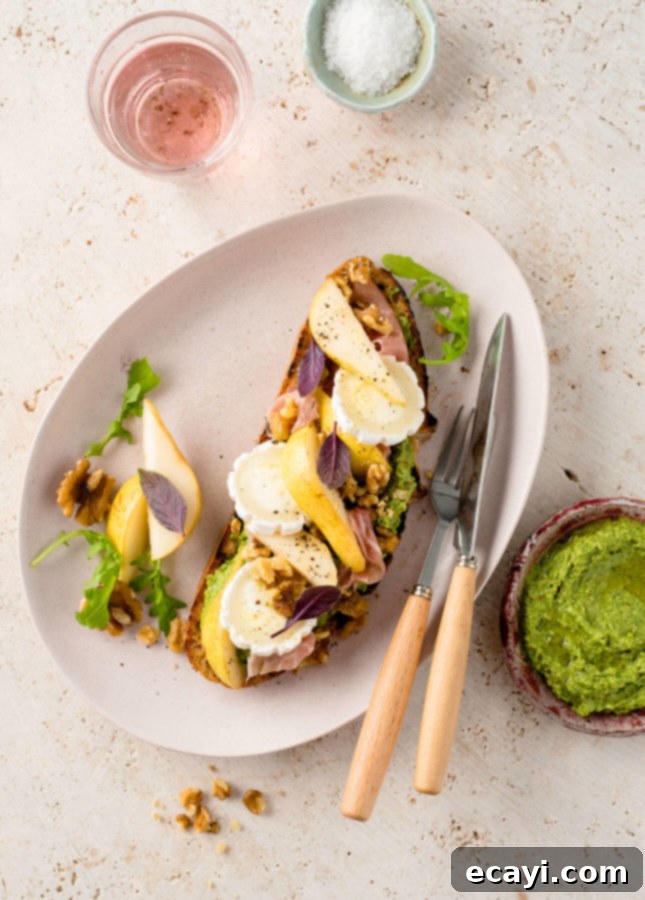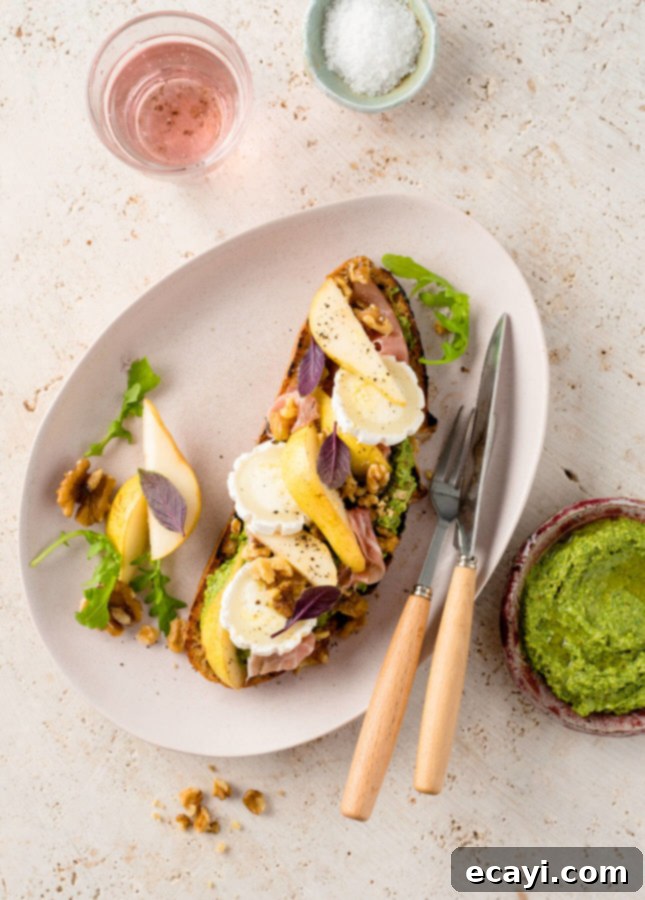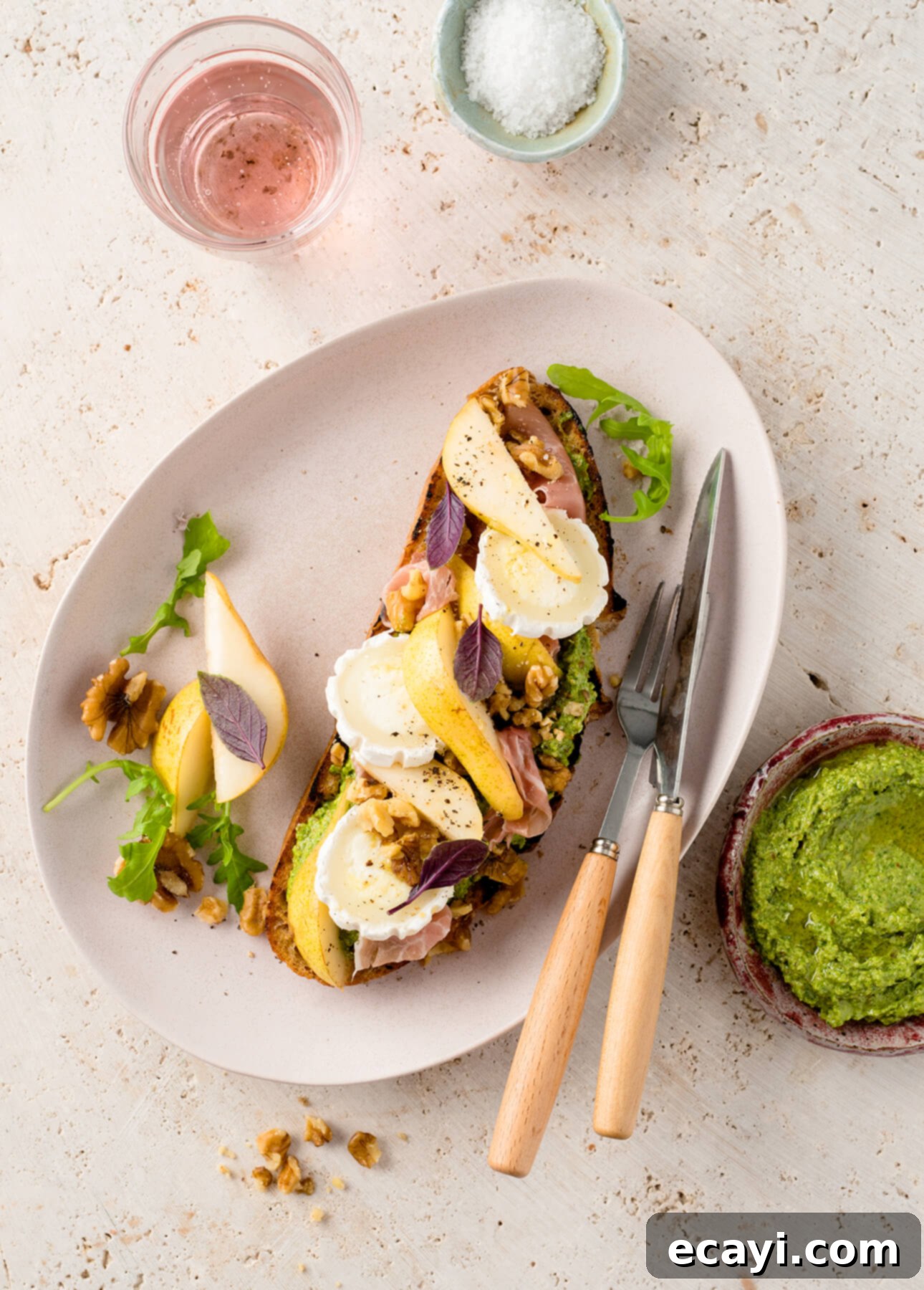Gourmet Goat Cheese and Pear Tartines with Arugula Walnut Pesto: An Elegant Brunch or Lunch Delight
Indulge in an exquisite culinary experience with these sophisticated Goat Cheese and Pear Tartines, beautifully complemented by a vibrant Arugula Walnut Pesto. This recipe is a symphony of flavors and textures, where the creamy tang of goat cheese meets the sweet juiciness of fresh pears, the salty crispness of prosciutto, and the peppery punch of homemade pesto, all served atop perfectly toasted sourdough. Whether you’re planning an impressive brunch, a light yet satisfying lunch, or a unique appetizer for guests, these tartines promise to be a showstopper that is surprisingly simple to assemble.

This post contains affiliate links. Full disclosure is at the bottom of the article.

Pin Recipe
Goat Cheese and Pear Tartines with Arugula Walnut Pesto
Ingredients
For the arugula walnut pesto
- 2 large handfuls arugula, about 3.5 oz (100 g)
- ½ cup chopped walnuts
- Zest and juice from ½ lemon, about 1 tsp (5 ml) zest and 2 tbsp (30 ml) juice
- 1 tsp honey
- ½ tsp kosher salt or fine sea salt
- Freshly ground black pepper
- ½ cup extra-virgin olive oil
For the pear tartines
- 2 large slices of wholewheat sourdough bread
- 4 thin slices prosciutto
- 1 ripe pear cored and sliced
- 3.5 oz goat cheese log, sliced
To serve
- Additional choppedwalnuts optional
- Extra-virgin olive oil
- Fleur de sel, or flaky sea salt
- Freshly ground black pepper
Instructions
For the arugula walnut pesto:
-
In a food processor, add the arugula, walnuts, zest and lemon juice, honey, salt, and black pepper. Pulse to coarsely chop the ingredients together. With the motor running, drizzle in the olive oil. Stop to scrape down the bowl and process until the pesto is smooth. Transfer to a glass jar or an airtight container and set aside. You can also make the arugula walnut pesto up to 4 days ahead and keep it refrigerated until needed.
For the pear tartines:
-
Toast the slices of sourdough bread, then set each one on a serving plate. Spread a generous amount of arugula walnut pesto over each tartine. Lay two slices of prosciutto over each tartine, then top with pear slices.
-
Garnish with chopped walnuts, a drizzle of olive oil, and a sprinkle of salt and pepper. Serve immediately.
-
STORAGE: The arugula walnut pesto will keep refrigerated for up to 4 days. You can also use this pesto in pasta, as a dip, or in a sandwich.
-
MAKE IT GLUTEN-FREE: Use gluten-free loaf bread.
Did you make this?
Tell me how you liked it! Leave a comment or take a picture and tag it with @foodnouveau on Instagram.
The Perfect Harmony of Flavors and Textures
These Goat Cheese and Pear Tartines aren’t just a recipe; they’re an experience. Every bite delivers a delightful interplay of complementary tastes and sensations. Imagine the peppery bite of fresh arugula pesto, rich with the earthiness of walnuts and brightened by lemon, spread generously over a perfectly crisp slice of toasted sourdough bread. Then comes the creamy, slightly tangy goat cheese, melting ever so slightly into the warm bread, providing a luxurious base. Layered on top, the delicate, salty whisper of prosciutto offers a beautiful counterpoint to the sweet, juicy slices of ripe pear. A final sprinkle of flaky sea salt and a drizzle of exquisite olive oil elevate this simple assembly into a gourmet masterpiece.
This dish truly shines because of its thoughtful balance. The sweetness of the pear and honey in the pesto is perfectly balanced by the saltiness of the prosciutto and the tang of the goat cheese. The soft textures of the cheese and pear contrast wonderfully with the crunch of the toasted bread and walnuts. It’s a versatile dish that feels special enough for entertaining yet quick enough for a weeknight indulgence.
Spotlight on Key Ingredients
The success of any great dish lies in the quality of its ingredients. For these Goat Cheese and Pear Tartines, each component plays a crucial role:
- Sourdough Bread: A robust, crusty sourdough is ideal. Its slight tang and chewy interior provide a sturdy foundation for all the toppings, holding up well to the moisture of the pesto and pear. The toasting process adds that irresistible crunch.
- Goat Cheese: A fresh, creamy goat cheese log is essential. Its distinctive tangy, earthy flavor pairs exceptionally well with sweet fruits and savory meats. Look for a good quality chèvre for the best results.
- Pears: A ripe but firm pear is key. Varieties like Bosc, Anjou, or Bartlett work wonderfully. You want a pear that offers sweetness and a slight crispness without being overly mushy. They provide a refreshing sweetness that cuts through the richness of the cheese and pesto.
- Prosciutto: Thinly sliced, high-quality prosciutto adds a beautiful salty, savory depth and a delicate texture. Its rich flavor complements both the cheese and the fruit.
- Arugula: The star of our pesto! Arugula brings a distinct peppery, slightly bitter note that balances the sweetness of the pear and honey. Choose fresh, vibrant green arugula for the best flavor.
- Walnuts: These nuts contribute a lovely earthy flavor and a subtle crunch to the pesto, enriching its texture and nutritional profile. They are a classic pairing with pears and cheese.
- Lemon: Fresh lemon zest and juice are crucial in the pesto, adding brightness and acidity that prevent the pesto from tasting heavy and help to preserve its vibrant green color.
- Honey: A touch of honey in the pesto rounds out the flavors, providing a subtle sweetness that harmonizes with the pear.
- Extra-Virgin Olive Oil: Use a good quality extra-virgin olive oil for both the pesto and the final drizzle. It ties all the flavors together and adds a luxurious finish.
Crafting the Arugula Walnut Pesto
The arugula walnut pesto is truly what sets these tartines apart. While traditional pesto uses basil and pine nuts, this variation offers a bolder, more unique flavor profile that is perfectly suited to the other ingredients. Making it from scratch is incredibly simple and yields a far superior taste to store-bought versions.
When preparing the pesto, ensure all your ingredients are fresh. The vibrancy of the arugula is paramount. A food processor makes quick work of this task. Start by pulsing the arugula, walnuts, lemon zest and juice, honey, salt, and pepper until coarsely chopped. This initial pulsing ensures everything is evenly broken down before the oil is added. Then, with the motor running, slowly drizzle in the olive oil. This gradual addition helps emulsify the pesto, resulting in a smooth, consistent texture. Don’t over-process; you want a smooth pesto, but not a paste. A slight texture from the walnuts is desirable. This pesto is not just for tartines; it’s incredibly versatile. Try it tossed with pasta, as a vibrant spread in sandwiches, or even as a dip for fresh vegetables. It keeps well in the refrigerator for up to four days, making it an excellent make-ahead component for various meals.
Assembling Your Elegant Tartines
Assembling these tartines is almost as enjoyable as eating them. The key is to work efficiently once the bread is toasted to maintain its crispness. Start by toasting your sourdough slices to a beautiful golden brown. Sourdough not only provides a fantastic base but its nooks and crannies are perfect for absorbing the pesto’s flavor without becoming soggy.
Once toasted, spread a generous layer of your freshly made arugula walnut pesto onto each slice. Don’t be shy; the pesto is a cornerstone of the flavor profile. Next, artfully arrange two slices of prosciutto on each tartine. The way the prosciutto drapes adds a touch of rustic elegance. Finally, top with the thinly sliced pear. You can overlap them slightly or arrange them in a fanned pattern. For the finishing touches, a sprinkle of additional chopped walnuts (for extra crunch and visual appeal), a drizzle of your best extra-virgin olive oil, and a dash of flaky sea salt and freshly ground black pepper will make all the difference. These small additions enhance both the taste and the presentation, signaling a truly gourmet creation. Serve immediately to enjoy the contrast of warm, crispy bread and cool, fresh toppings.
Serving Suggestions and Pairings
These Goat Cheese and Pear Tartines are incredibly versatile and can be served in many contexts:
- For Brunch: Pair them with a simple green salad dressed with a light vinaigrette, a fresh fruit platter, and perhaps some scrambled eggs for a more substantial meal. A mimosa or a sparkling rosé would be a perfect beverage accompaniment.
- For Lunch: They make a fantastic light lunch on their own or alongside a bowl of creamy tomato soup or a hearty lentil soup.
- As an Appetizer: Cut the large tartines into smaller, bite-sized pieces for an elegant appetizer at your next gathering. They are sure to impress guests with their sophisticated flavor profile.
- Wine Pairing: For wine lovers, these tartines pair beautifully with a crisp Sauvignon Blanc, a light-bodied Pinot Grigio, or even a dry Prosecco or Cava. The acidity and effervescence will cut through the richness of the cheese and complement the fruit.
- Non-Alcoholic Pairings: Try serving with sparkling water infused with cucumber and mint, or a freshly brewed iced tea.
Tips for Success
- Choose Ripe Pears: A ripe pear will be slightly soft near the stem. However, avoid overly soft or bruised pears, as they will be too watery and won’t slice cleanly.
- Thinly Slice Ingredients: For optimal texture and ease of eating, slice the pears and goat cheese thinly. This ensures each bite gets a balanced mix of flavors.
- Don’t Over-Toast: Toast the sourdough until it’s golden and crisp, but not burnt. A slight chewiness in the center is desirable.
- Fresh Pesto is Best: While the pesto can be made ahead, fresh pesto always has the most vibrant flavor.
- Season Generously: Don’t forget the final touches of flaky sea salt and black pepper; they truly enhance the overall taste.
Variations to Explore
While the classic Goat Cheese and Pear Tartine is divine, feel free to experiment with these variations:
- Cheese Alternatives: If goat cheese isn’t your preference, consider creamy brie, tangy blue cheese (for a bolder flavor), or even crumbled feta.
- Nut Swaps: Pecans or even toasted pine nuts can be used in the pesto instead of walnuts for a different nutty note.
- Herb Variations: Add some fresh basil or parsley to your arugula pesto for a more complex herbal flavor.
- Meat Options: If prosciutto isn’t available, crispy bacon or thinly sliced smoked turkey could be interesting substitutes. For a vegetarian option, simply omit the prosciutto.
- Sweet Touches: A drizzle of balsamic glaze over the finished tartine can add an extra layer of sweetness and acidity.
- Herb Garnish: Finish with a few fresh thyme sprigs or finely chopped chives for an added aromatic touch.
This recipe is a testament to how a few high-quality ingredients can come together to create something truly extraordinary. The combination of sweet, salty, creamy, and crunchy elements makes these Goat Cheese and Pear Tartines with Arugula Walnut Pesto a memorable dish that you’ll want to revisit again and again.
This site is a participant in the Amazon Associates Program, an affiliate advertising program designed to provide a means for the site to earn fees by linking to Amazon and affiliated sites.
If you click on an affiliate link, I may earn advertising or referral fees if you make a purchase through such links, at no extra cost to you. This helps me creating new content for the blog–so thank you! Learn more about advertising on this site by reading my Disclosure Policy.
